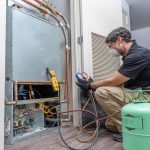You’ve likely driven past a house with a “For Sale by Owner” sign, surrounded by caution tape and boarded-up windows. Maybe you’ve wondered who would buy such a property. The truth is, fire-damaged houses attract a range of buyers, each with their own strategies and motivations. From fix-and-flip investors to owner-occupants, these buyers see opportunity where others see ruin. But what drives them to take on the challenges that come with a fire-damaged property? And how do they turn these properties into profitable investments?
The Fire-Damaged House Market
Frequently, homebuyers and investors overlook the fire-damaged house market, which can be a treasure trove of opportunities.
You might think that a fire-damaged house is a lost cause, but that’s not always the case. Many of these properties can be renovated and resold for a profit, or even occupied by you or your tenants.
You’ll often find that fire-damaged houses are priced lower than comparable properties in the same area, making them an attractive option for those looking to get into the real estate market without breaking the bank.
When you’re considering purchasing a fire-damaged house, it’s essential to inspect the property thoroughly to determine the extent of the damage.
You’ll want to assess the structural integrity, electrical and plumbing systems, and any necessary repairs. Don’t be afraid to negotiate the price based on your findings, as the seller may be motivated to sell quickly.
With the right mindset and approach, you can turn a fire-damaged house into a valuable investment or a beautiful home.
Types of Fire Damage Buyers
As you explore the fire-damaged house market, you’ll encounter various types of buyers who are drawn to these properties for different reasons.
There are the fix-and-flip investors, who aim to renovate the property quickly and sell it for a profit. These buyers typically have a team of contractors and a solid understanding of the renovation process.
Then, there are the buy-and-hold investors, who plan to renovate the property and rent it out or hold onto it for long-term appreciation. These buyers often have a more patient approach and may be willing to do more extensive renovations.
You’ll also come across owner-occupants, who plan to live in the property themselves. These buyers might be looking for a good deal or a unique opportunity to put their own stamp on a property.
Some may be handy and willing to take on renovation work themselves, while others might hire contractors to do the work for them.
Lastly, there are the wholesale buyers, who purchase fire-damaged properties with the intention of reselling them to other investors or buyers.
Each type of buyer has their own strengths and weaknesses, and understanding their motivations can help you navigate the fire-damaged house market.
Why Investors Buy Fire-Damaged Homes
Why Investors Buy Fire-Damaged Homes
With fire-damaged homes often selling at a discount, investors are drawn to these properties because they offer a unique opportunity to purchase at a lower price point than comparable undamaged homes in the same area.
You can acquire a property at a significantly lower cost, which means you’ll have more room in your budget for renovations and repairs. This increased margin can result in higher profits when you resell the property.
Additionally, you may be able to negotiate a better deal with the seller, who may be motivated to sell quickly due to the damage.
This can give you even more bargaining power and further increase your potential profit. Furthermore, many fire-damaged homes still have a solid foundation and intact structural elements, which can reduce the overall cost of repairs.
Renovation Challenges and Opportunities
Several fire-damaged homes require extensive renovation work, which can be a daunting task for even the most seasoned investors.
You’ll need to assess the extent of the damage, from charred walls to damaged electrical systems, and prioritize repairs accordingly. This process can be time-consuming and costly, especially if you’re dealing with structural damage or hazardous materials like asbestos.
As you embark on the renovation journey, you’ll encounter opportunities to upgrade and modernize the property.
You might choose to install energy-efficient appliances, replace outdated plumbing, or add new insulation to improve the home’s overall livability. Additionally, you can reconfigure the floor plan to better suit modern living standards or incorporate smart home features to increase the property’s value.
Throughout the renovation process, it’s essential to stay organized, set realistic timelines, and budget accordingly.
You’ll need to navigate local building codes, permits, and inspections, ensuring that your work meets the necessary standards. By doing so, you’ll transform a fire-damaged property into a safe, comfortable, and desirable home that will attract potential buyers or renters.
Profiting From Fire-Damaged Properties
You’ve overcome the renovation challenges and transformed a fire-damaged property into a safe and desirable home.
Now, it’s time to reap the rewards of your hard work. You can profit from fire-damaged properties in several ways.
One option is to flip the property, selling it for a higher price than you paid. Since you’ve already done the renovations, you can attract buyers who are willing to pay a premium for a move-in ready home.
Another option is to rent the property out, generating passive income through rental yields.
You can also consider holding onto the property long-term, as its value appreciates over time.
Additionally, you can sell the property to a real estate investment trust (REIT) or a real estate fund, which can provide a quick exit strategy.
Whatever route you choose, it’s essential to have a solid understanding of the local market, property values, and rental yields to maximize your profits.
Conclusion
You’ve now got a better understanding of the fire- sell my house fast house market and the types of buyers who are drawn to these properties. Whether you’re a fix-and-flip investor, a buy-and-hold investor, an owner-occupant, or a wholesale buyer, there are opportunities to be had. Just remember to do your due diligence, crunch the numbers, and be prepared for the renovation challenges that come with fire-damaged homes. With the right strategy, you can turn a damaged property into a profitable investment.



